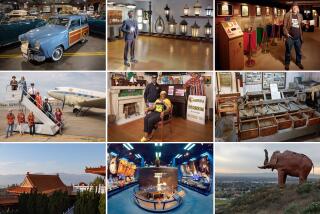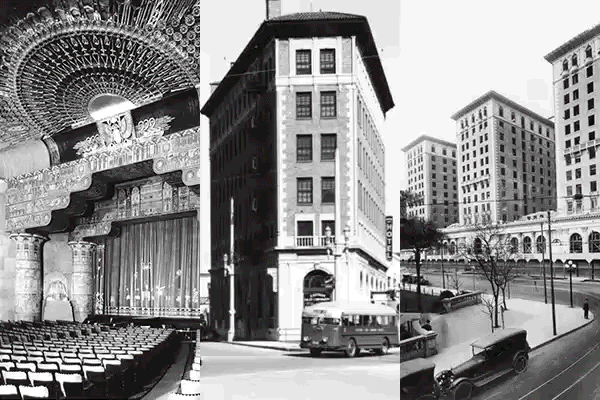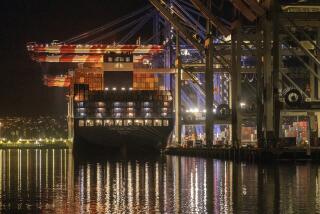California History: It All Comes Together in Exposition Park
- Share via
Literary and pictorial treasures that the Los Angeles County Museum of Natural History has been acquiring since its founding in 1913 are now housed in a recently completed storage and library facility at the museum in Exposition Park.
The collection, called the Seaver Center for Western History Research, contains a wide range of rare volumes tracing the state’s past from the era when it was under Spanish rule, through the period when the Mexican flag flew over its presidios from San Diego to San Francisco, and finally its acquisition by the United States.
One of the museum’s prized works is a three-volume edition written by Capt. George Vancouver, “A Voyage of Discovery to the Pacific Ocean and Round the World,” published in London in 1798.
Focused Attention on Area
During a three-year voyage in his vessel Discovery, Vancouver made new explorations on the coast of Australia and New Zealand, visited Hawaii, then called the Sandwich Islands, and mapped the Pacific coast from San Diego to Cook’s Inlet, Alaska.
While his impressions of California occupy but a small segment of Vancouver’s narrative, the geographical knowledge obtained by his voyage was to have an ultimate effect upon California’s future. It focused attention on an area of the world that still remained a mystery to most Europeans and Americans.
The Discovery sailed through San Francisco’s Golden Gate on Nov. 14, 1792. A boat sent ashore returned with a Franciscan priest and a sergeant who was acting commandant of the presidio. The English received a warm welcome and were given fresh provisions. A work party was sent to procure wood and water. Vancouver and his officers went into the adjacent hills to shoot quail. The captain was also making notes on the weakness of fortifications in San Francisco, its inadequate armament and the small size of its garrison. He would continue this at other California posts, and include this data in his narrative. It would have strategic value to his nation should Britain attack Spanish settlements in California.
Vancouver visited Monterey, Santa Barbara and San Diego during a leisurely stay along the coast before returning to Hawaii. He would write excellent descriptions of life in the Franciscan missions and the Spanish pueblos, always including observations of their vulnerability against foreign attack:
“Santa Barbara is a post of no small consequence, and might be rendered very tenable, by fortifying a hill conspicuously situated on the north-west side of the roadstead; yet they have only two brass nine-pounders, placed before the entrance into the Presidio. . . . With little difficulty St. (San) Diego might also be rendered a place of considerable strength, by establishing a small force at the entrance of the port where, at this time, there were neither works, guns, houses, or other inhabitations nearer than the Presidio, which is at a distance of at least five miles from the port, and where they have only three small pieces of brass cannon. . . .”
‘Nothing Was Perceived’
Vancouver considered Los Angeles an insignificant community and had doubts that it existed. Off San Pedro, he noted in his log on Sunday, Nov. 24, 1795:
“I had been given to understand that a very advantageous settlement is established on a fertile spot somewhere in this neighborhood within sight of the ocean, though at the distance of some miles from the coast called Pueblo de los Angeles; ‘the country town of the Angels,’ formed in the year 1781. This establishment was looked for in all directions, but nothing was perceived that indicated either habitations or inhabitants.”
In addition to rare books, the center also has a collection of more than 200,000 photographs and negatives tracing the development of Los Angeles, Southern California and the West. Errol Stevens, associate curator of historic records at the museum, is in charge of non-book material in the library, which includes photographs, daguerreotypes, maps and film. He removed a folder from a cabinet, placing a number of photographs it contained on a table. It was a panoramic view of the growth of Los Angeles that could be arranged in a chronological sequence.
First there were pictures showing the city when the roads converging on it were wagon traces, and the downtown streets were unpaved; dusty during the dry season and quagmires when it rained. The horse and buggy and stagecoaches were the principal conveyances until the early 1900s when automobiles made their appearance. Horse-drawn streetcars would be replaced by electric trolleys that would be developed into a network of interurban trains, which would accelerate the growth of communities throughout the Southland.
Important Event
One of the most important events in the city’s history took place on Sept. 6, 1876, when the Southern Pacific crossed the Tehachapis and joined Los Angeles to San Francisco by rail. The Bay City was the western terminus for the transcontinental railroad that spanned the continent.
George Pullman had introduced the first modern sleeping car in 1864, and as years passed, more luxurious accommodations were added. A gentleman might pause for an aperitif and a good cigar in the observation car. A tumbler of good Kentucky bourbon was a quarter. Passing to the diner, one discovered the tables set with glistening silver, crystal glassware and china embossed with the railroad’s logo. The cuisine was of gourmet quality.
Santa Fe reached Los Angeles during the 1880s, and a rate war with Southern Pacific brought thousands of new arrivals to Los Angeles. On Nov. 27, 1892, Santa Fe began running its California Limited between Los Angeles and Chicago. Later it would boast in its advertising that it had a luxury car on the Limited for every travel need: sightseeing, sleeping, dining or socializing.
There are other photographs showing the development of the oil industry, agriculture, and Hollywood from the days of the silent films, but most fascinating are the faces that stare into the camera, men and women of a bygone era who lived in a time when life was far less complex.
Prolific Photographer
A number of local photographers are represented in the collection. One of the most prolific was Adam Clark Vroman, a Pasadena book dealer with a great love for the outdoors. In 1955, the museum acquired more than 2,000 glass plate negatives Vroman made during his photographic expeditions. Following his death in 1916, his negative collection was acquired by Los Angeles County. For years it remained locked in storerooms until it was moved to the museum.
Among his plates are pictures of the 21 Franciscan missions, which he photographed in 1895 before they were restored. Vroman settled in Pasadena in 1894, opening a book and stationery store. It is located today at 695 E. Colorado Blvd. One of his favorite projects was a study he made of the American Indian. He carried his camera throughout Arizona and New Mexico visiting remote tribes. Some of the best of Vroman’s negatives are pictures he took in Yosemite during an 1895 visit. Here amid the quiet grandeur of majestic surroundings he composed photographs that are remarkable for their clarity and definition.
The new library was made possible by a grant from the Seaver Institute that was founded in 1955 by Frank Roger Seaver, an attorney, industrialist and philanthropist who had built the Hydril Co. into a national leader in the production of specialized oil field equipment. Since his death in 1960, the Seaver Institute has continued to support a wide range of educational, scientific and social projects.
“The Seaver Center is open to all,” said Kathy Donahue, the chief librarian. “There is material here that will be of value not only to scholars, but to anyone with an interest in local, California and western history.”
The library is open from Tuesday through Friday from 10 a.m. to 4 p.m. Because of limited seating in the present reading room, visitors are asked to call (213) 744-3359 for an appointment. There is no admission charge to the museum for those using the library.
More to Read
Sign up for Essential California
The most important California stories and recommendations in your inbox every morning.
You may occasionally receive promotional content from the Los Angeles Times.










